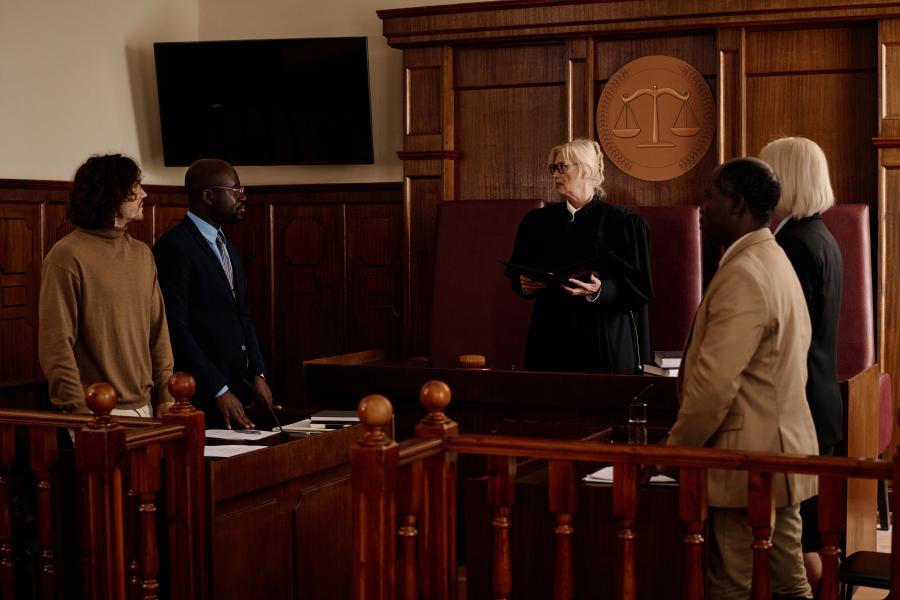Okay, so let’s talk about how appeals are decided by something called a three-judge panel. Imagine you’re in a talent show, and instead of one judge deciding if you win, there are three judges who work together. That’s kind of how it works in appellate courts! These judges review the case, talk about it, and then vote on what should happen.
What Is a Three-Judge Panel?
When someone appeals a court decision, their case is usually decided by three judges, chosen randomly. These judges are like referees—they don’t care who wins or loses; they just want to make sure the rules were followed.
How Are the Judges Picked?
The judges don’t pick their cases or panels. A clerk or circuit executive’s office does that. It’s like drawing names out of a hat!When Do You Know Who the Judges Are?
Each court has its own rules for when they announce the names of the judges. Sometimes you find out early, and sometimes it’s closer to the court date.
Who Are the Players?
- The Appellant:
This is the person or party who lost in the original trial and wants the appellate court to change the decision. They file something called a written brief (kind of like a really detailed letter) explaining why they think the trial court made a big mistake.Example:
If someone says, “The trial court ignored important evidence in my case!” they’d explain that in their brief.
- The Appellee (or Respondent):
This is the person or party who won in the trial. They also file a written brief saying, “Nope, the trial court got it right!” or, “Even if there was a mistake, it wasn’t a big deal.”Example:
The appellee might say, “The evidence wasn’t ignored—it wasn’t important, so the trial court did the right thing!”
How Do They Decide the Case?
Most of the time, the judges make their decision by reading the written briefs from both sides. This happens in more than 80% of cases! But sometimes, the judges want to hear directly from the lawyers.
- Oral Argument:
This is when both sides get a chance to stand up in court and explain their case to the judges. Each side has a set amount of time (like a timer in a game), and the judges can interrupt to ask questions.Example Question:
A judge might ask, “If we agree with you, how would this affect other cases like this one?”Cool Fact:
Oral arguments are open to the public, so anyone can sit in and watch!
What Happens Next?
After the judges review the written briefs and/or oral arguments, they make a decision. This is called a panel decision, and it’s usually written down with an explanation of why they ruled that way.
- How Do They Vote?
The three judges vote on the outcome. It can be:3-0: All three judges agree.
2-1: Two judges agree, and one disagrees.
If a judge disagrees, they might write something called a dissenting opinion, explaining why they think the decision was wrong.
Precedents Matter:
Judges follow “precedents,” which are similar cases that were already decided by their court or the Supreme Court. It’s like using a recipe that’s been tested before to make sure they get it right.
What Happens After the Decision?
The panel’s decision usually ends the case, but not always. Here are the things that could happen next:
- Remand:
The judges might send the case back to the trial court to fix something or hold a new trial.Example:
“The trial court didn’t let one side present important evidence, so they need to do it again.”
Rehearing by the Panel:
One of the parties might ask the same judges to look at the case again, especially if they think something was missed.En Banc Review:
This is when all the judges in the court of appeals (not just three) review the case. It’s like calling in the whole team for a second opinion.Supreme Court Review:
A party can ask the Supreme Court to review the case, but it’s super rare. The Supreme Court only takes about 1% of the cases that ask for a review!
Why Is This Important?
Three-judge panels are a big part of making sure court decisions are fair. They don’t hold new trials or hear from witnesses—they just make sure the trial court didn’t mess up. And even though most decisions are final, there are ways to ask for more review if something really big is at stake.
Gaps and Suggestions for Improvement:
- Explain Why Three Judges Matter:
Add a section explaining why there are three judges instead of one. For example:It reduces bias (more people = fairer decisions).
It helps balance different perspectives, especially if one judge sees things differently.
- Expand on Oral Arguments:
Include more details about how oral arguments work, such as:Typical time limits (e.g., 15 minutes per side).
Whether lawyers can bring visual aids.
How judges use these sessions to test the lawyers’ arguments.
Clarify What Happens After the Decision:
Expand the explanation of what “remand” and “en banc review” mean with more concrete examples.Add Visuals:
Suggest using a flowchart or timeline to show the steps from filing an appeal to the panel decision.Include Fun Facts:
For example, mention how panels are random to ensure fairness or how dissenting opinions can sometimes influence future cases.
Example Additions
Why Three Judges Are Better Than One:
Having three judges on a panel is like having a group project where everyone checks each other’s work. If one judge sees something wrong, the others can help make sure the final decision is solid.
Expanded Oral Argument Section:
During oral arguments, judges might ask tough questions like:
“What’s the strongest precedent that supports your case?”
“If we agree with you, what stops this from causing problems in other cases?”
Some lawyers bring charts or diagrams to make their points clear, but the judges mostly want solid legal arguments, not flashy presentations.


